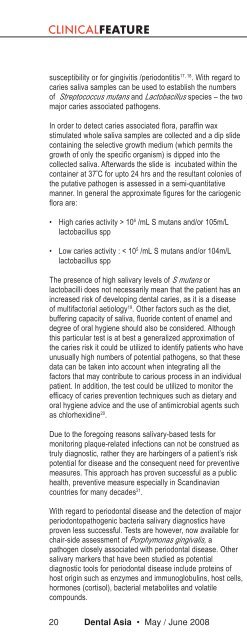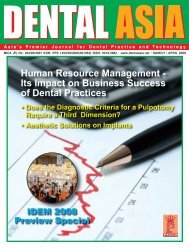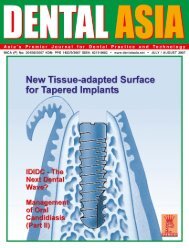Download - Dental Asia
Download - Dental Asia
Download - Dental Asia
You also want an ePaper? Increase the reach of your titles
YUMPU automatically turns print PDFs into web optimized ePapers that Google loves.
CLINICALFEATURE<br />
susceptibility or for gingivitis /periodontitis 17, 18 . With regard to<br />
caries saliva samples can be used to establish the numbers<br />
of Streptococcus mutans and Lactobacillus species – the two<br />
major caries associated pathogens.<br />
In order to detect caries associated flora, paraffin wax<br />
stimulated whole saliva samples are collected and a dip slide<br />
containing the selective growth medium (which permits the<br />
growth of only the specific organism) is dipped into the<br />
collected saliva. Afterwards the slide is incubated within the<br />
container at 37 º C for upto 24 hrs and the resultant colonies of<br />
the putative pathogen is assessed in a semi-quantitative<br />
manner. In general the approximate figures for the cariogenic<br />
flora are:<br />
• High caries activity > 10 6 /mL S mutans and/or 105m/L<br />
lactobacillus spp<br />
• Low caries activity : < 10 5 /mL S mutans and/or 104m/L<br />
lactobacillus spp<br />
The presence of high salivary levels of S mutans or<br />
lactobacilli does not necessarily mean that the patient has an<br />
increased risk of developing dental caries, as it is a disease<br />
of multifactorial aetiology 19 . Other factors such as the diet,<br />
buffering capacity of saliva, fluoride content of enamel and<br />
degree of oral hygiene should also be considered. Although<br />
this particular test is at best a generalized approximation of<br />
the caries risk it could be utilized to identify patients who have<br />
unusually high numbers of potential pathogens, so that these<br />
data can be taken into account when integrating all the<br />
factors that may contribute to carious process in an individual<br />
patient. In addition, the test could be utilized to monitor the<br />
efficacy of caries prevention techniques such as dietary and<br />
oral hygiene advice and the use of antimicrobial agents such<br />
as chlorhexidine 20 .<br />
Due to the foregoing reasons salivary-based tests for<br />
monitoring plaque-related infections can not be construed as<br />
truly diagnostic, rather they are harbingers of a patient’s risk<br />
potential for disease and the consequent need for preventive<br />
measures. This approach has proven successful as a public<br />
health, preventive measure especially in Scandinavian<br />
countries for many decades 21 .<br />
With regard to periodontal disease and the detection of major<br />
periodontopathogenic bacteria salivary diagnostics have<br />
proven less successful. Tests are however, now available for<br />
chair-side assessment of Porphymonas gingivalis, a<br />
pathogen closely associated with periodontal disease. Other<br />
salivary markers that have been studied as potential<br />
diagnostic tools for periodontal disease include proteins of<br />
host origin such as enzymes and immunoglobulins, host cells,<br />
hormones (cortisol), bacterial metabolites and volatile<br />
compounds.<br />
Of these, host-derived enzymes and other inflammatory<br />
mediators originating from the gingival crevice appear to hold<br />
the greatest promise as salivary diagnostic tests for<br />
periodontal disease both on an individual basis or on a<br />
community wide assessment of risk for periodontal disease.<br />
The recent exciting developments on the potential role of<br />
periodontal disease as a risk factor for cardiovascular and<br />
cerebrovascular diseases 22 and the incidence of pre-term lowbirth-weight<br />
babies 23 bring new impetus to this aspect of<br />
salivary diagnostics.<br />
It is now well recognized that Helicobacter pylori are the<br />
causative agents of a significant proportion of gastritis and<br />
duodenal ulcers (peptic ulcer disease) in humans and, it may<br />
also play a role in gastric cancer 24 . Studies have also shown<br />
that dental plaque biofilms may act as a reservoir of H pylori<br />
in some of these individuals. Hence attempts have been<br />
made to use saliva as a diagnostic aid for peptic ulcer<br />
disease. A nested PCR assay is now available to detect H.<br />
pylori DNA in saliva and confirm the presence of H. pylori<br />
infection in patients 25 . Other immunologic studies indicate that<br />
saliva may also be used for predicting risk for gastric<br />
adenocarcinoma 26 .<br />
Saliva from patients with a variety of other disorder including<br />
shigellosis, pigeon breeders disease and Lyme disease have<br />
been evaluated for the presence of specific antibodies, with<br />
mixed results 27 . But with the increased sensitivity of tests and<br />
advancing technology it is likely that saliva would be used as<br />
an important diagnostic fluid for such disease entities.<br />
Auto-immune Disorders<br />
When body defenses turn against itself as seen in many<br />
autoimmune disorders, diseases such as Sjögren’s syndrome<br />
may ensue. The latter is a chronic, illness characterized by<br />
20 <strong>Dental</strong> <strong>Asia</strong> • May / June 2008





